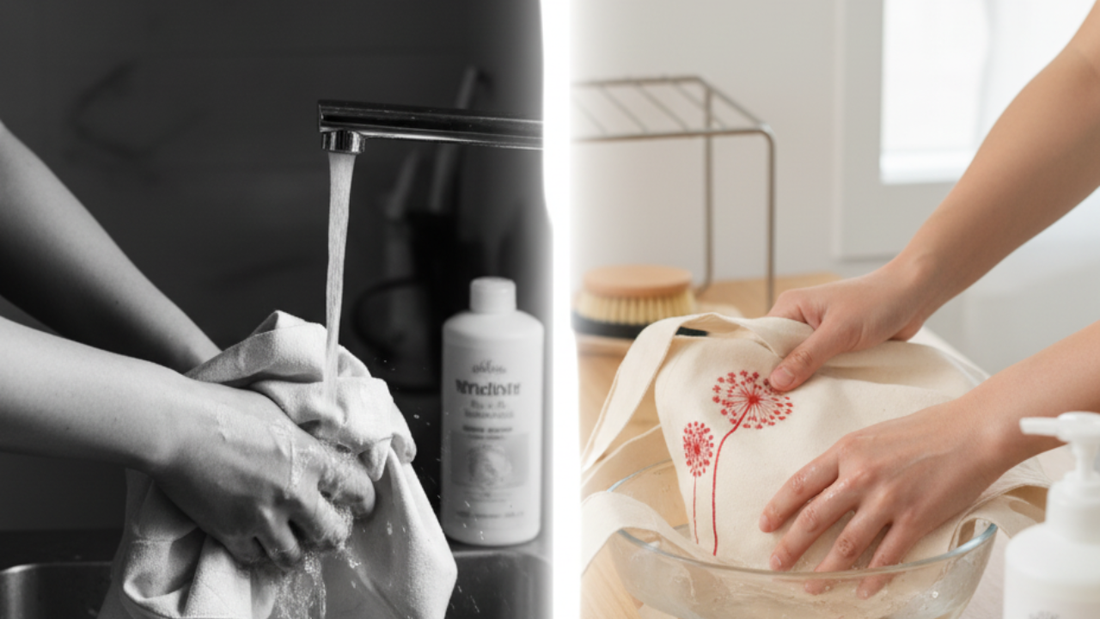Reusable tote bags are great for shopping, errands, and everyday use. But over time, they collect dirt, stains, or even bacteria. To keep them fresh, strong, and safe, here are easy steps you can follow.
Why Cleaning Your Tote Bag Matters
Your tote bag touches many surfaces—grocery carts, countertops, floors, and more. That means germs, spills, dust, or food crumbs can build up. According to cleaning experts, reusable bags should be cleaned regularly to avoid cross-contamination and foul smells.
Also, frequent cleaning helps prevent odors, fabric wear, and fading. A clean bag lasts longer and keeps you healthier.
Read the Label: Understanding Fabric Instructions
Before washing, check if your tote has a care label or tag. Different materials require different treatment:
-
Cotton or canvas: Often machine washable (cold or gentle cycle).
-
Polypropylene / synthetic / nonwoven: Usually safe to hand wash or use gentle machine wash in cold water.
-
Insulated bags, jute, or bags with decorations/leather: May need spot cleaning or hand wash only.
Following the label protects prints, seams, and fabric integrity.
Pre-Cleaning Tips: Shake, Empty, and Spot Treat
Before any full wash:
-
Empty all pockets and shake out crumbs or debris.
-
Brush off loose dirt inside and outside.
-
Spot treat stains: Use a mild detergent or diluted soap, apply it gently to the stain, and let it sit a few minutes. Use a soft brush or cloth to lift the stain.
-
Test for colorfastness: dampen a small inside area with water and see if color bleeds onto a white cloth. If yes, wash gently and separately.
These steps make the full washing safer and more effective.
Washing Methods: Machine vs. Hand Wash
Hand Wash (Safest Option)
-
Fill a basin with cold or lukewarm water.
-
Add mild, bleach-free detergent.
-
Submerge the bag and gently agitate. Focus on stained areas with a soft brush or cloth.
-
Rinse thoroughly until no soap remains.
- Gently press out excess water (don’t wring).
Machine Wash (If Label Allows)
-
Turn the bag inside out to protect prints and seams.
-
Use a gentle or delicate cycle with cold water.
-
Wash it alone or with similar fabrics to prevent color transfer.
-
Use a mild detergent. Avoid bleach or fabric softeners.
After washing, remove it right away to prevent dampness and mildew.
Choosing the Right Detergent for Tote Bags
The detergent you use matters a lot. Here’s how to pick one that protects your bag:
-
Use a mild, bleach-free detergent. Harsh chemicals can weaken fibers or fade colors.
-
Avoid fabric softeners—they leave a residue that can reduce absorbency or dull the fabric.
-
For natural cleaning, baking soda or white vinegar (in small amounts) can help remove odors and lift stains without damaging the fabric.
-
Start with a small amount of detergent—too much can be hard to rinse out.
A good detergent choice ensures cleanliness without harming your tote’s material.
Drying Safely Without Damaging Your Bag
How you dry your reusable tote bag matters almost as much as how you wash it. Here’s how to dry safely:
-
Air dry whenever possible. Hang the tote in a well-ventilated spot or lay it flat. That helps preserve the shape and prevents shrinkage.
-
Avoid high heat. If your tote’s material allows a dryer, choose a low or no-heat setting. High heat can weaken fibers, fade colors, or distort the shape.
-
Reshape while damp. If the bag’s panels or handles have warped a bit after washing, gently reshape before it fully dries.
-
Avoid direct sunlight for long periods. Ultraviolet rays can fade fabrics over time, so a shaded drying area is best.
Proper drying helps maintain strength and appearance, keeping your tote usable longer.
Removing Tough Stains Without Harsh Chemicals
Some stains just don’t come out with regular wash cycles. But harsh chemicals can damage your tote. Try these gentler stain removal tips:
-
Spot treat immediately. The sooner you address the stain, the easier it is to remove.
-
Use mild solutions. A mix of water and gentle dish soap, or baking soda paste, can do wonders.
-
Test first. Always try your cleaning mixture on a small hidden area to ensure it won’t discolor the fabric.
-
Gently rub, don’t scrub. Use a soft cloth or sponge. Abrasive scrubbing may damage fibers.
-
Repeat if needed. Sometimes it takes two or three gentle applications rather than one aggressive one.
These steps help you get rid of tough spots without weakening the bag.
Storage Tips to Keep Totes Fresh
How you store your tote bag between uses affects its condition. Try these tips:
-
Empty it out fully. Don’t leave crumbs, dirt, or damp items inside; they invite mildew or smell buildup.
-
Fold or hang neatly. If there’s a hook or hanger, use it so the shape isn’t crushed.
-
Store in a dry place. Avoid damp closets or basements where moisture can creep in.
-
Avoid overstuffing. Even when storing, don’t cram things in the tote that stretch seams or warp handles.
Good storage practices help your bag stay fresh and functional.
Repairing Small Tears and Loose Seams
Even with good care, bags may suffer small damage over time. Repairing early helps prolong life:
-
Re-stitch loose seams. Use a strong thread and sew along the weakened area.
-
Use reinforcing patches. For canvas or heavy fabric, a small patch inside or outside can reinforce strained areas.
-
Use bias tape or trim. At stress points, applying a strip of durable fabric over the seam edge can cover frays and add strength. (This is a known repair method for worn seams on tote bags.)
-
Invisible “ladder stitch” repairs. This technique helps close seams from the inside with minimal visible stitching.
- Act while damage is small. It’s easier to repair a tiny hole early than deal with a large tear later.
Repairing promptly keeps the bag usable and saves you from full replacements too soon.
When It’s Time to Let Go and Recycle
At some point, every reusable tote bag will wear out. Knowing when to retire a bag is part of good maintenance:
-
Check for irreparable damage. If the fabric is too thin, seams shredded, or handles beyond repair, it may be time.
-
Consider usability. If the bag no longer carries weight well or leaks through, it’s less useful.
-
Recycle or repurpose. Many tote bags can be cut up and used as cleaning rags or for crafts. If the material is recyclable, look into textile recycling in your area.
- Choose a quality replacement. Use what you’ve learned from your past tote to pick one with stronger materials or better construction.
Retiring a bag responsibly means you get value out of it and reduce waste.
Suggested Article: How a Good Yoga Tote Bag Can Keep You Motivated to Practice
Conclusion
Caring for your reusable tote bags is simple but vital. Start by emptying and spot treating, then choose the right washing method based on the fabric and label. Use a gentle detergent and avoid harsh chemicals. With thoughtful washing, your tote bag will stay clean, strong, and ready for daily use. For sustainable and high-quality textiles, you can explore Loom Home Textiles.





